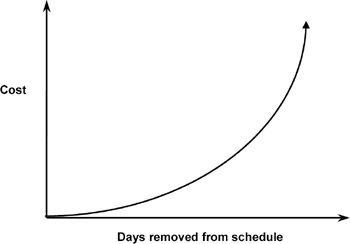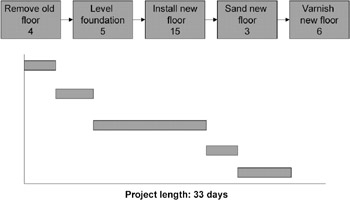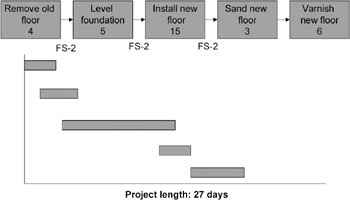What is crashing and fast-tracking a schedule?
|
Crashing and fast-tracking a schedule are ways of reducing the length of a project schedule. Crashing is a general term for reducing project schedules. When we crash a schedule, we spend money or resources to reduce the scheduled time for the project in such a way that we do the things that have the greatest reduction in schedule for the least amount of cost. When we first start to crash a schedule, relatively small amounts of money and resources need to be spent to get rather large reductions in project time. As we continue to reduce schedules, the relative cost increases.
Fast tracking is a special kind of schedule reduction. When we fasttrack, we take items that were originally scheduled to be done in sequential order and reschedule them to be done in parallel or partially in parallel. Fast tracking will also increase cost but, more important, it will increase risk. When we have several tasks in a project taking place at the same time and something goes wrong or a problem develops, it may be necessary to disrupt all of the activities in progress.
Tell me more …
In an ideal world, all schedules would be optimized in such a way that the time for doing the project and the cost of doing the project would be at a minimum. This is not always the case, and even if it were, we would have managers and stakeholders who would not be satisfied with the predicted date of completion for the project. We will often be asked to reduce the project completion date. Reducing the project completion date means completing the project earlier.
The first thing we should recognize about schedule compression is that there is no value in making any schedule changes to activities that have total float or free float greater than zero. In other words, the only way we can reduce the overall schedule of a project is by reducing the schedule of the tasks that are on the critical path. The critical path determines the overall duration of the project. Items that are not on the critical path have no effect on schedule reduction efforts.
Notice also that as we reduce the schedule by reducing the number of days in the schedule, we are reducing the number of days in the critical path. This also reduces the number of days of total float in the activities that are not on the critical path. Eventually these activities will have their total float reduced to zero, and they will join the critical path as well. As we continue to reduce the schedule length, more and more activities will join the critical path, and it will become more and more difficult and expensive to reduce the schedule. As we can see in Figure 5-16, the cost of reducing the schedule will increase more and more rapidly as we take more and more days from the schedule.

Figure 5-16: THE COST OF REDUCING SCHEDULES
There are many means of crashing a schedule. Reducing the scope of the project will generally reduce the project completion date. If the stakeholders really want to get the project completed early, one of the easiest ways of reducing the schedule is to simply reduce the scope of the project. This can be done by eliminating some of the requirements or delaying them to a later date as in a phased-in approach to project delivery. When this is done, care must be exercised to be sure that what is delivered in the early phases of the project is useful as a stand-alone part of the project and not something that depends on the undelivered part of the project to be usable. It does the customer no good to receive 75 percent of the project if that 75 percent depends on the undelivered 25 percent in order to be used.
Additional resources can be used to shorten the project schedule as well. This can be done by adding resources to the project or by using the resources that are already present on an overtime basis. Adding resources creates a problem for the project team because the additional resources must somehow be absorbed by the project. If we add equipment resources, we must have people to operate the equipment. The additional people required to operate the new equipment must be trained.
If we add human resources to the project, there must be training and familiarization with the project before they can become productive. The new human resources will slow down the already present human resources and cause a further slowdown of the project and a loss of productivity while they are being trained and made familiar with the project tasks.
Creating additional resources by using mandatory overtime is also not without problems. Many companies do not pay an overtime premium for overtime work and some do not pay anything at all for overtime worked. Under the conditions of imposed or forced or mandatory overtime work, there is a noticeable reduction in productivity. This reduction in productivity may reduce the number of productive hours a person works to the point where the actual number of productive hours worked is less than the number of productive hours worked on straight time.
Fast tracking, the special case of crashing, means attempting to do things in parallel that would have normally been scheduled to be done in sequence. Suppose we have a project to install a new gymnasium floor at the university basketball arena. We could begin by removing the old floor, leveling the foundation, installing the new floor, sanding the new floor smooth, and varnishing the new floor.
It can be seen in Figure 5-17 that this project will require thirtythree days to complete. Using this method each step of the new floor installation will be completed before the next step is taken.

Figure 5-17: INSTALLING A NEW FLOOR: ORIGINAL SCHEDULE
In Figure 5-18 an attempt has been made to reduce the schedule. By allowing two days of lead to take place on the second, third, and fourth activities, we can improve the schedule by six days. This is not without problems either. We will begin leveling the foundation while the old floor is still being removed. This may cause some interference problems if the people tearing up the old floor do not have the debris removed as they work. It may also be a problem if parts of the old floor are in place where the foundation leveling people need to work. The new floor installers may also have problems if the areas where they have to work are still being leveled by the foundation levelers. The sanding operations are scheduled to begin two days before the floor installers are complete with their work. If the sanding operations create large amounts of dust, it might slow down or prevent the floor installers from working. There is no overlap on the varnish operation because the dust from the sanding operation would ruin the finish on the varnish.

Figure 5-18: INSTALLING A NEW FLOOR: FAST-TRACKED SCHEDULE
|
EAN: 2147483647
Pages: 126